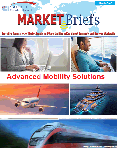Interview with Sean Yarborough, VP-Product Management, ST Engineering iDirect
Herndon, Va., March 18, 2022--To shed light on ST Engineering iDirect's advanced mobility solutions for various verticals such as the aeronautical, maritime, rail and other markets, Satellite Markets and Research spoke with Sean Yarborough, VP-Product Management,
ST Engineering iDirect. Excerpts of the interview follows:
Please give us a brief overview of ST Engineering iDirect’s offerings for advanced mobility applications?
To begin with, we offer various waveforms in our portfolio to address a variety of use cases. Our latest innovation is Mx-DMA MRC which brings forth the full scalability of TDMA return technologies to the same SCPC-like efficiency that mobility networks require.
We offer an NMS capability specifically designed to support mobility networks. It offers the ability to manage tens of thousands of terminals that are across many different gateways, satellites, and beams. This is especially important in terms of mobility as the service provider must be able to manage dynamic traffic efficiently.
Beam switching is a key aspect that many claim, but the devil is in the details. Mobility terminals are constantly switching beams and
 |
Sean Yarborough |
sometimes satellites, especially in the case of aero. The amount of time it takes to switch beams is critical to the overall service offering. If the service is out for minutes at a time versus one to two seconds, it completely changes the SLA and therefore the perception of the service. Our advanced mobility technology enables very fast beam acquisition so the timeframe to re-acquire the network and to switch beams is as fast as possible.
Fast beam switching is critical, but service providers also need tools that will minimize the loss of the connection in the first place. Our advanced mobility technology maintains link robustness, dynamically maximizes transmission throughput while avoiding the creation of interference on other carriers and modems and mitigates potential satellite blockage to minimize loss of a signal and to provide a superior re-acquisition environment when it does happen.
Quality of service (QoS) is another exceptional aspect of our advanced mobility, including global QoS in some of our platforms to ensure that quality of service is maintained consistently anywhere a remote terminal travels.
We’re also now seeing networks that have heterogeneous user requirements such as a mix of ships and aircraft for example, which results in wide variation of terminal sizes and throughput requirements per terminal. The ability to be able to manage all of those different types of throughput and antenna performance requirements within a single network is a key differentiator for service providers.
What advantages does your advanced mobility solution package portfolio have over your competitors? What would you say are the key benefits for your customers?
I would say that it’s not about calling out one feature benefit here or there. It’s actually about the combination of all these offerings and how they work together to raise the level of the whole system. This is what makes our service offering so unique.
Our market presence is so significant because of some of the features we’ve talked about.
The fact that we offer global QoS for customers means that they can have confidence in their ability to deliver a high availability service wherever they are in the world. Our global bandwidth management or global QoS function is unique in that aspect.
We enable service providers to offer high availability networks despite rain fade or other extreme weather events. In addition to beam switching, service providers can set up redundant gateway and NMS infrastructure to keep the system always up even when disaster strikes one area.
Customization is another differentiator to our advanced mobility offering. Our platforms are API-driven meaning they allow service providers to establish new roles and new operation methodologies to create something uniquely their own to take to market. It’s the same with QoS management. In some cases, our APIs allows service providers in consult with their customers to customize their beam switching algorithms.
Can you cite some examples of implementations using your advanced mobility technology?
We work with nearly all the largest mobility network operators globally including Inmarsat’s Global Xpress network, which is the largest mixed-use mobility network in the world, as well as thousands of installations on Intelsat’s Flex, SES’ Skala and Eutelsat’s Advance networks, which are managed services. Beyond pure satellite operators, we also support service provider partners including Panasonic Avionics in commercial aviation and Speedcast and Marlink across all segments of maritime. Of course, this is all in addition to large fixed segment business with most of these partners as well.
What can we expect from ST Engineering iDirect in the coming months in terms of advanced mobility solutions? What developments can you tell us about?
We will expand our platforms and solutions to become multi-orbit moving forward and we will have the ability to support ground infrastructure and dynamically allocated capacity for software defined satellites. We’ll also focus on integration with the telco standards, so you’ll see more 5G proof of concept work along with actually interfacing to MEF standards in the near future.
We consider network virtualization and cloud native technologies as critical enablers to this interface. Today, all of our traditional RF technology and our data processing technology is at the teleport, gateway and hub. Given the scale of NGSO networks, we can’t continue to put all of that infrastructure into a single physical location. When you do that, you’re not necessarily optimizing the full processing capability either. We have already centralized processing at a data center (and we’re going to continue to innovate in this area). So, just like IT organizations have a data center running for all of their HR applications, their security applications, and all their other internal applications, our customers now have the ability to centralize data processing for their teleports using network virtualization. This allows them to scale their hardware needs and processing requirements up and down based on the actual demand of service growth.
We are collaborating with industry partners on the technology and standards necessary to achieve better interoperability. Specifically, we were founding members of the Digital Interface Standards (DIS) Group which consolidated with the Digital IF Interoperability Consortium (DIFI) to address the need for a standardized RF interface between modulator, modem and RF components for easier interoperability of virtualized components in the cloud. As an example, look to the aero market and consider the time it takes for all of satellite switches in a typical flight. Terminal operators and airlines are looking to minimize the amount of beam switches or satellite switch times, creating the need for multiple modems. The goal is the ability to deploy a single piece of hardware that meets the needs but may require two modems in one terminal to support various waveforms and capacity.
Another innovation in our NMS technology makes it completely virtualized to run in the public cloud. We expect that centralized data processing will still happen in the private cloud for each one of our customers but our NMS, which is primarily doing configuration and stats retrieval, could be managed in a public cloud environment. This allows service providers to scale the NMS over time. In some cases, it allows them to invest in and deploy a solution at a lower cost. Both kinds of scenarios – centralized data processing or centralized and mass management in the public cloud – require cloud native Kubernetes technology that virtualizes our applications and makes them more accessible and scalable for our customers.
The other side of the story is at the edge. Whilst we are virtualizing the core technology, we are also innovating on the modem side. We are working on virtualizing our modems to offer the ability to run third party applications. This will give service providers the advantage of adding external processing at the edge directly on-premises, which would lower their costs and simplify ease of installation and deployment.
The bottom line is that we want to help our customers serve their customers better with excellent service and flexibility in terms of how they go to market.
What types of changes is ST Engineering iDirect preparing for in the scope of mobility? How does it plan to meet these challenges or opportunities?
It really starts with the changes in the satellites themselves. There’s an expansion of orbits. Traditionally, the orbits have been primarily GEO-based. Now almost every provider is looking at a multi-orbit offering so that they can tailor their services to the unique needs of their end users. So, for example, where they need higher throughput and less delay, they might be looking at MEO or LEO constellations. If they are looking for more global coverage they will go to GEO.
A significant opportunity is primarily centered around the capability of the satellites. Software defined satellites enable service providers flexible capability to enable coverage and capacity anywhere and in real-time. Before we had constellation maps to know where static beams are, today, these beams can be adjusted in real-time to either ensure coverage for a distinct area or to ensure capacity and throughput to meet certain SLAs. This is a level of orchestration that is a brand-new requirement for most of the market, and definitely something that we as a ground infrastructure provider must start to accommodate.
 |
| To read or download a pdf of a MarketBrief report on Advanced Mobility Solutions sponsored by ST Engineering iDirect click here. |
The other big trend we are seeing is around the move towards integration with telco standards. We’re seeing almost all of our larger customers look to some of the telco standards that many organizations have already defined to enable them to carry out orchestrated services, carrier service levels and agreements. Our customers are looking for that same level of capabilities within the satellite network so they can have more interoperability between a satellite network and terrestrial network. If you are a telco provider, with both satellite and fixed fiber offerings, you want to be able to offer your enterprise customers a common definition of service and a common Service Level Agreement (SLA), regardless of the access type. If I’m offering a service over fiber to one location, when I want to offer that service in a remote location using satellite, I will require some of the same telco capabilities in terms of configuring that service and offering the service itself. So, again, you’re seeing this need to adapt, which has already have been proven to work in the telco space and by adopting this, we can achieve interoperability and improved efficiency in terms of operations because you’re using interfaces and standards that are already been deployed elsewhere.
From the perspective of mobility, if you think about airplanes, ships and vehicles for example, the need to have visibility of things and people across the entire supply chain is driving that need to integrate with telco standards and to provide a consistent standard of service across them.
Then there is the shift of information to the cloud. In the maritime segment particularly, there is great demand for real-time access to information, part of what we call digitalization. Part of that digitalization is moving things into the cloud so that multiple stakeholders can access data whether it is around inventories or the operational efficiency of a vessel. Moving this data into the cloud also drives this necessity to have reliable, real-time connectivity.





